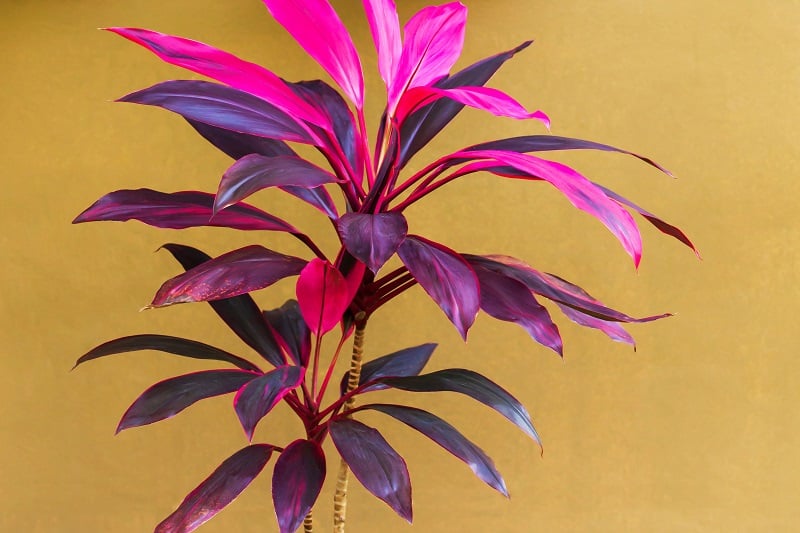
Cordyline plants, with scientific name Cordyline fruticosa, are evergreen flowering plants of the family Asparagaceae. Also known as ti, they are common decorative plants ideal for both indoors and outdoors. They are native to New Zealand, Southeast Asia and Papua New Guinea. These plants have leathery, spear-like leaves and come in various colors including red, yellow, white, purple, green and purplish-red, but certain conditions may also cause their leaves to turn yellow.
Cordyline leaves turning yellow: Common reasons
Incorrect watering technique or poor water quality
Cordyline leaves could turn yellow and drop off if you are not watering them enough or are overwatering them. Too much water or excess moisture around the roots could drown them and may result in root rot.
Check the moistness of the soil with your fingers before watering to ensure you are watering the plants properly. See to it that the soil is moist but not waterlogged, and also check that it is draining effectively.
Poor water quality could also result in leaf discoloration such as yellowing leaves. This usually happens if you use tap water for the plants. Let this sit for a while to dissipate excess salts, or use bottled or distilled water. Rainwater is also an ideal choice and works wonders on plants.
Fungal diseases such as Fusarium leaf spot
Cordyline leaves could turn yellow due to fungal diseases like Fusarium leaf spot. This disease specifically targets the younger leaves, and also causes both stem rot and root rot. The roots will appear waterlogged and will become black.
To fix the problem, destroy the affected plants. Keep the leaves dry to prevent infection and water the plants just enough. Make sure the soil has good drainage so that excess water does not remain stagnant in the soil.
Fluctuating temperatures or too much sunlight
Cordyline leaves could also turn yellow due to rapid temperature fluctuations. Do not place the plants near too much heat or too much sun. Abrupt changes or a rise in temperature could turn the leaves yellow. There is no cure for this; just allow the affected leaves to fall off.
Exposure to too much sunlight can result in sunburn, manifesting as yellowing leaves, and can harm the plants. This usually happens when you suddenly transfer your plants from indoors to outdoors.
See to it that the plants get abundant indirect sunlight so they can still get the benefits of light, such as more vivid leaf colors. If you wish to move the plants outdoors, acclimatize them slowly to the new conditions.
The plants could be pot-bound
If you notice rootlets appearing on the top of the soil, it could be that the plants are pot-bound. Remove the plants from the planters and inspect the root ball. If the root ball looks congested and fills the pot, it means the plant needs more space. Cordyline plants prefer a lot of root space to survive.
If you are confronted with this issue, consider transferring the plants to a garden setting so the roots can spread further.
It could be natural shedding
Your plants may just be shedding their older leaves naturally, which results in the yellowing of the older leaves. Cordyline plants tend to grow tall and, in the process, lose their older leaves. This is a natural shedding process, so you do not have to worry about it.
Cordyline plant care
Cordyline plants are sensitive to fluoride, which is present in almost everyone’s water supply. Consider bottled or rainwater for your watering needs.
Make sure that the plants are not placed in areas with direct sunlight, although these plants do also need bright light. The green-leaved variety tends to tolerate direct light, while those with colored leaves may prefer bright indirect or filtered sunlight.
These plants need a rich, well-draining soil mix with a pH of at least 6 to 6.5.
Always make sure that the soil is continuously moist for your ti plants. Water the soil once it starts to feel dry, and reduce watering during the winter.
Apply fertilizers during the spring, preferably with slow-release pellets. You may feed the plants weekly during their growing season. Use a liquid 20-20-20 fertilizer at half-strength, but do not fertilize during the winter.
Cordyline or ti plants can thrive in areas where the temperature is above 62 degrees Fahrenheit. They prefer high humidity. Place your plants away from windows or cold drafts. If you notice ongoing leaf drop, raise both the humidity and the temperature.
Conclusion
Cordyline or ti plants are great outdoor and indoor plants because of their colorful foliage. However, they are also prone to conditions that cause yellowing leaves. Cordyline leaves may turn yellow due to underwatering, overwatering or fungal diseases like Fusarium leaf rot. It could also be due to being pot-bound, or fluctuating temperatures and too much sunlight.
Image: istockphoto.com / Tanes Ngamsom